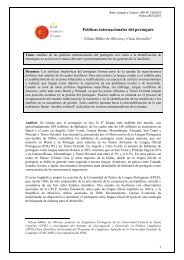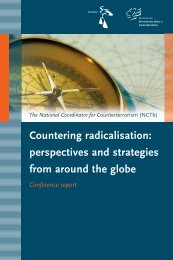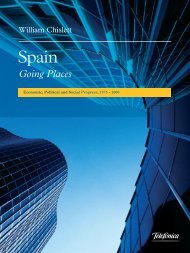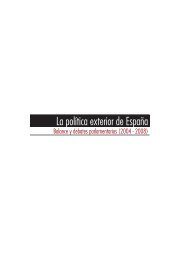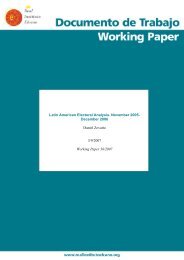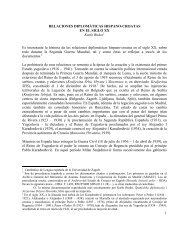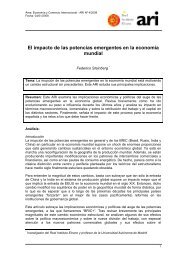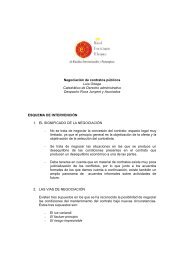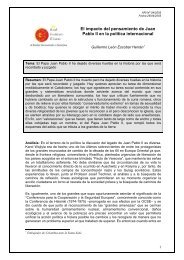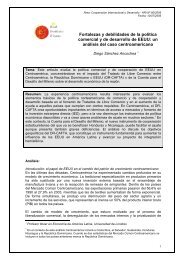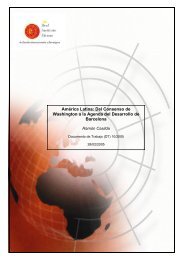Spain and the United States - Real Instituto Elcano
Spain and the United States - Real Instituto Elcano
Spain and the United States - Real Instituto Elcano
Create successful ePaper yourself
Turn your PDF publications into a flip-book with our unique Google optimized e-Paper software.
OVERVIEW 17<br />
money was used to purchase cotton, fertiliser, tractors, wheat, coal, equipment<br />
for railways <strong>and</strong> for <strong>the</strong> development of mining <strong>and</strong> hydroelectric power.<br />
Truman sent Stanton Griffiths as ambassador to <strong>Spain</strong> at <strong>the</strong> end of 1950, after<br />
<strong>the</strong> <strong>United</strong> Nations allowed ambassadors back into <strong>the</strong> country following a<br />
break of four years, <strong>and</strong> Admiral Forrest Sherman, chief of naval operations,<br />
met with Franco. In 1951, <strong>the</strong> US Congress voted <strong>Spain</strong> a fur<strong>the</strong>r $100 million.<br />
<strong>Spain</strong>’s real GDP jumped 17.6% in 1951, in no small part due to <strong>the</strong> US<br />
inflows, which began to reactivate an economy “held toge<strong>the</strong>r by bailing wire<br />
<strong>and</strong> hope.” 9<br />
Franco played hard to get <strong>and</strong> in return for <strong>the</strong> bases repeatedly held out<br />
for large amounts of money that Washington rejected. In <strong>the</strong> final stages of <strong>the</strong><br />
arduous negotiations, he told his negotiators “in <strong>the</strong> last resort, if you don’t get<br />
what you want, sign anything <strong>the</strong>y put in front of you. We need that<br />
agreement.” 10 By <strong>the</strong> time <strong>the</strong> Pact of Madrid to establish air bases at Torrejón<br />
(near Madrid), Zaragoza <strong>and</strong> Morón de la Frontera <strong>and</strong> a naval base at Rota<br />
was signed in 1953, Dwight Eisenhower, <strong>the</strong> comm<strong>and</strong>ing general of <strong>the</strong><br />
victorious forces in Europe during World War II, was president. As a military<br />
man, he was more in tune with Franco than Truman (who in a press conference<br />
had equated Franco’s regime with Hitler’s <strong>and</strong> Stalin’s 11 ). Eisenhower became<br />
<strong>the</strong> first US president to visit <strong>Spain</strong> in 1959.<br />
The agreement was controversial, especially for France <strong>and</strong> Great Britain,<br />
which believed it undermined <strong>the</strong> moral authority of <strong>the</strong> Western block, <strong>and</strong> for<br />
liberals in <strong>the</strong> <strong>United</strong> <strong>States</strong>, democrats in <strong>Spain</strong> <strong>and</strong> Spaniards in exile. France<br />
<strong>and</strong> Britain, however, were trading with <strong>Spain</strong>. When asked why France was<br />
importing oranges from <strong>Spain</strong>, De Gaulle famously said that he “didn’t think<br />
oranges were fascist”. A New York Times editorial said <strong>the</strong> <strong>United</strong> <strong>States</strong> was<br />
“swallowing a bitter pill” 12 , <strong>and</strong> <strong>the</strong> American Protestant community expressed<br />
its outrage. For Franco, <strong>the</strong> agreement was a triumph, particularly as no<br />
political liberalisation was dem<strong>and</strong>ed. The dictator’s regime gained<br />
international respectability, especially in <strong>the</strong> multilateral area (<strong>Spain</strong> joined <strong>the</strong><br />
<strong>United</strong> Nations in 1955). Internally, <strong>the</strong> dictatorship felt more secure with US<br />
troops on its soil, although by <strong>the</strong>n <strong>the</strong> threat to it from <strong>the</strong> political opposition<br />
was negligible as it was weak <strong>and</strong> divided. As a contemporary analyst put it,<br />
<strong>Spain</strong> had gone “from <strong>United</strong> Nations outcast to <strong>United</strong> <strong>States</strong> partner”. 13<br />
9. See New York Times, quoting a report by a US economic mission (October 28, 1951).<br />
10. See p. 623 of Franco by Paul Preston (HarperCollins, 1993).<br />
11. “There isn’t any difference between <strong>the</strong> totalitarian Russian government <strong>and</strong> <strong>the</strong> Hitler government<br />
<strong>and</strong> <strong>the</strong> Franco government in <strong>Spain</strong>. They are all alike.” (Documentary History of <strong>the</strong> Truman Presidency, vol.<br />
25, p. 45).<br />
12. See New York Times (September 28, 1983).<br />
13. See “Franco’s Foreign Policy: From UN Outcast to US Partner” in World Today (vol. 9, no. 12,<br />
December 1953).



